Ronaldo: Hello everyone, we are arriving with another Pod in Focus, our business podcast in focus, here on our RPTV channel 8 on NET for more than 10 cities for more than 3 million viewers for our YouTube, our Instagram and our page Facebook Pod in Focus.
Today we are going to combine joy with happiness and wonder, that delicious thing that many people do only outside of business, but today we are going to meet someone who uses this within his business because it is wonderful and it is something very important.
Today we will get to know the Felipe Jannuzzi, he is the founder of Mapa da Cachaça, Espíritos Brasileiros and BR-ME.
We will meet this wonderful young man who has an incredible story about cachaça. Did you know that there are more than 40.000 cachaça manufacturers in our Brazil.
And before we talk about this Mapa da Cachaça in Brazil we will talk to him Felipe Jannuzzi. Welcome my dear to our Pod in Focus.
Felipe: Thank you, Ronaldo. It's a pleasure to be with you and the entire Pod em Foco team to present a little bit of this Brazil of cachaça.
Ronaldo: Look how cool we are, we love interviewing successful businesspeople. Entrepreneurs who built a fantastic life story because the most important thing about Pod em Foco is motivating people. It's about making people keep dreaming, keep fighting for their dream, doing wonderful things and that's why the first question is always
Felipe: I'm from Campineiro, but I've lived in São Paulo for almost 15 years. I'm married to a woman from Rio Grande do Sul. I am the father of Clara and Catarina, just like you, I am from Palmeiras. I'm passionate about good Brazilian things, but not because they're Brazilian, because they're really good. No jingoism, no exaggerated nationalism, but when we start to study our products a little more, and not just cachaça, but coffee, Brazilian olive oil, which is winning awards all over the world, and that inspires me. You know, all my projects are linked to this theme of Brazilianness.
But what made me enter this world of Brazilianness head first was cachaça and it was even my first project on this topic of portraying Brazil using, so to speak, these fantastic scapegoats that are these products of our gastronomy.
Felipe: I studied communication, but there is even a university course on cachaça. For example, there are doctors in cachaça at ESALQ in Piracicaba here in São Paulo, in Lavras in Minas Gerais, there is also a higher education course in cachaça. In Salinas, in the north of Minas, there is also a higher education course in cachaça.
Then you can be a doctor in cachaça. There is even incredible research on the topic because it is a topic that has many disciplines. You can be a historian and study cachaça, you can be a biologist studying cachaça, a chemist. It's a very rich topic and I ended up not entering academia but my studies were always in parallel.
I always took courses at the University, but my greatest learning was the stills I visited. It was going on the road and getting to know the productions, many of which are centuries old, and starting to learn more about this Brazil, about this Brazilian production, right there with the producers.
Felipe: The idea came up at my and Gabriela Barreto’s college. We are trained in communication. And just like you, we like to talk to entrepreneurs, but from a very specific niche, which are cachaça entrepreneurs. O Mapa da Cachaça emerged to be a bridge between producers and consumers, or other people who are interested in hearing these stories.
O Mapa da Cachaça It is a cultural project, in 2014 we won the award at the Mystery of Culture for the best cultural project in Brazil and it even gave us subsidies to be able to travel more and even go abroad to speak about this topic.
Then Eduardo Martins also joined the project, which also helped us look at a more sensorial side of cachaça. To understand more about Brazilian wood. So as I said: it is a topic of multiple disciplines.
Today my main focus is this sensorial part, very motivated to understand more the role of the terroir of the cachaça, that is, to understand why a cachaça from the interior of São Paulo is different from the cachaça from the interior of Minas, for example.
Brazilian woods, for example, we have dozens of woods for aging cachaça. And they influence the color, aroma and flavor of the cachaça. And that's something we only have, no one in the world has that. Nobody in the world has amburana, jaquetiba-rosa, ipê, balsam. And each one brings a very distinct particularity to the drink. And the whole world wants to know that today, Ronaldo.
Nowadays, out there, there is beer that passes through Brazilian wood, there is whiskey that passes through Brazilian wood. And so we have a lot to offer. And when we talk about cachaças it really motivates me that at the end of the day we are talking about Brazil.
Ronaldo: The most interesting thing, right? It's a culture, is that sometimes we don't see cachaça in that way but it's a story since the founding of Brazil, when the Portuguese came here and you tell this story in the video you sent to me.
Since the 16th century we have been producing cachaça in Brazil. This historical part is very rich because you can talk, for example, about Brazil's economic cycles through cachaça. First, you had a large concentration of producers on the Brazilian coast with sugar cane plantations.
Later in the Gold Cycle, with the population moving to the interior of Brazil, to Minas Gerais, they also took cachaças with them. And they began to create cachaça production hubs in those regions. So today, Minas is recognized as a major producer of cachaça. This began in the Gold Cycle. So it's a story you tell about the people of Minas Gerais, who have this even more intimate relationship with drinking, which dates back to that time.
Paraty, which is also a hub for cachaça production, had more than 100 cachaça stills in the XNUMXth century. The word paraty itself is synonymous with cachaça. You even have a series of Brazilian stories that we can tell and create an overview of Brazil.
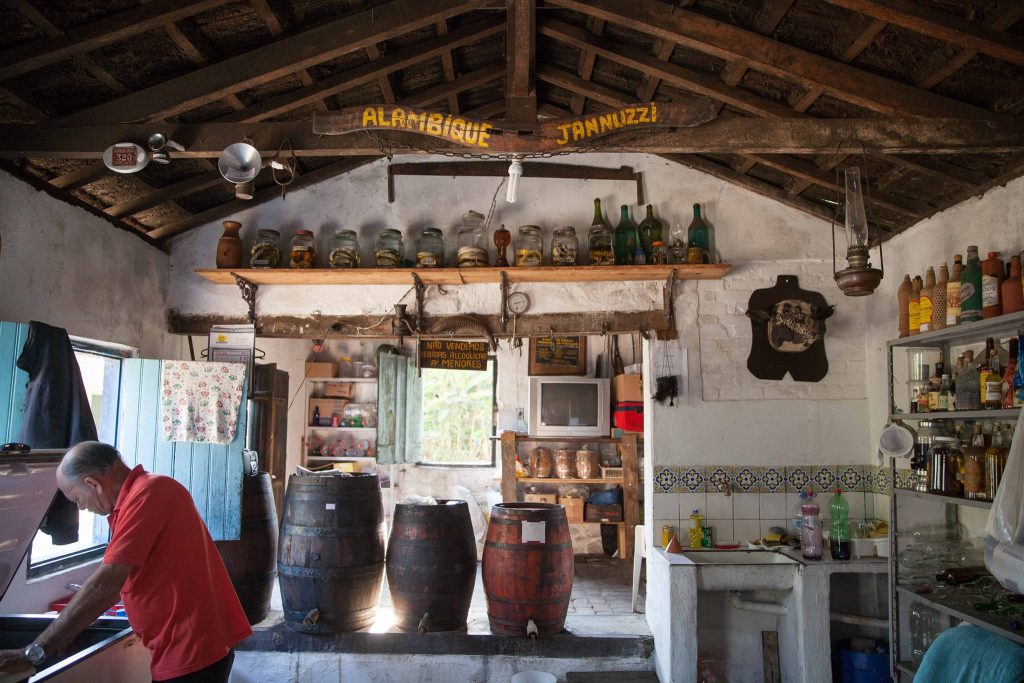
You can talk about cachaça in São Paulo and about Italian migration. I myself, after a few years visiting stills, discovered a Jannuzzi family in Caçapava producing cachaça. It was a branch of the family that left Italy and went to Caçapava and started making cachaça. So there is a still that has been producing cachaça for over 100 years. So you tell a lot of the story of Italian migration to São Paulo with the production of still cachaça.
And São Paulo today is the region in the world that produces the most sugarcane, it has a lot of plants, a lot of stills, so it's really cool that you can tell these stories through gastronomy. I think the best way to tell a story is to have a drink, a plate of food. It's literally a full plate for you to tell the story of a people, a culture and that's what cachaça is. Cachaça is the history of the Brazilian people and began in the colonial period, so there are Portuguese, there are indigenous people, there are slaves and there is all the migration. And all this mixture also helped to create this history of the Brazilian drink and
I can tell you that it was somewhere on the Brazilian coast between 1512 and 1532. I say this because we don't have an official document that says exactly who, when and where the first cachaça was produced. But we have three hypotheses: Pernambuco, Bahia or on the coast of São Paulo in São Vicente. In fact, here in São Vicente, on the coast here in São Paulo, the Portuguese construction is called Engenho dos Erasmos which is still standing and today it is a historical heritage maintained by USP.

It is possible to visit there and then there is the hypothesis that it was one of the birthplaces of cachaça in 1532 when a Dutchman and three Portuguese distilled there possibly the first cachaça.
What we can say is that it was at the beginning of the 16th century, that is, it was before rum in the Caribbean. Although rum is a drink much better known around the world than cachaça, which is also produced from sugar cane, its production is newer.
The Dutch who produced sugarcane in northeastern Brazil in the period known as Dutch Brazil, when the Dutch colonized Pernambuco, they produced a type of cachaça from leftovers from the sugar industry. Sugar itself was the great wealth of the time. But with the by-product of sugar production, with molasses, a sugarcane spirit was made.
When the Portuguese expelled the Dutch, they went to the Caribbean and took the stills there and took this technology of producing this drink from molasses to make what we know as rum.
I found a document from the 19th century in which the Portuguese court, at the time in Rio de Janeiro, asked a cachaça producer for a drink that he called in this letter a laranjinha celeste. And what is the celestial orange? It is a cachaça that producers used and still place today in the column or during distillation in the copper still, that copper pan where distillation takes place, orange or tangerine leaves, and when the vapor passes through these leaves it adds this beautiful bluish color. So if you take this bottle and put it in the light, this beautiful bluish touch will appear and there will also be more citrus characteristics to the drink.
So you go to Maria Isabel's still, to Paratiana's still, to Coqueiro's still, all of them, each with their own recipe and their production of Azuladinha from Paraty.
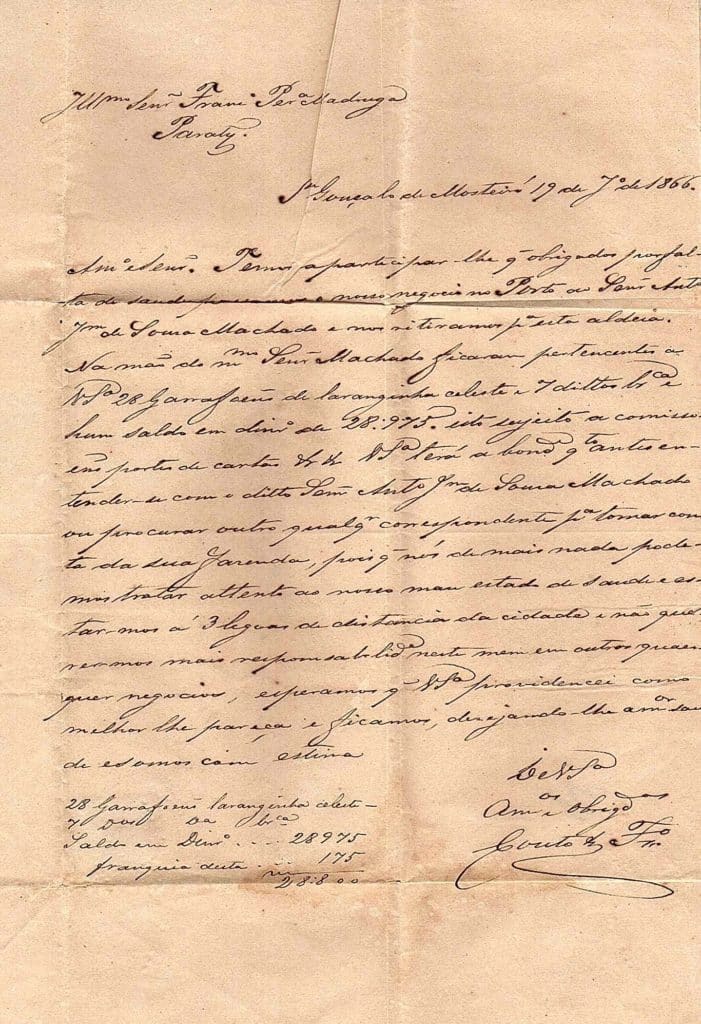
Espíritos Brasileiros was my and my partners’ desire to produce a special distillate.
When I came across this richness of our biodiversity, and cachaça speaks this very well when we think about Brazilian wood and when we also think about the bottled drinks, which are those popular drinks and medicines.
It's available for all types of illnesses. Even São Paulo has the close body: every Holy Week in the city of Monte Alegre do Sul people mix cachaça with guine and rue and drink it to protect against evils of both the body and the soul.
And also, this is fantastic because once again we talk about culture, we talk about history, rituals, but then I also brought another variable to my research which is the Brazilian plants.
We can quote more than 30 Brazilian woods used today for cachaça but if you think about the bottles we also talk about seeds, roots, leaves and then I went crazy. Well, this is too much, right? And precisely at that time, Mapa da Cachaça I went to give a talk in Berlin at an event there called Bar Convent and in an incredible warehouse they set up this event and it is one of the biggest events in the spirits industry in the world and I was there and I saw that the big thing is Gin.
Gin is a drink that contains a variety of botanicals and you need to have juniper, which is a very common plant in Europe. In Brazil we still don't have juniper. But then each country, each region, takes juniper macera in an alcoholic base and mixes it with a bunch of local plants.
So Gin from Germany has plants from Germany. From Spain, there is a plant from Spain. And I said, I'm in Brazil, the country with the greatest biodiversity in the world and we don't have a gin with Brazilian plants? Do you want to know, let's do one? Brazilian gin!
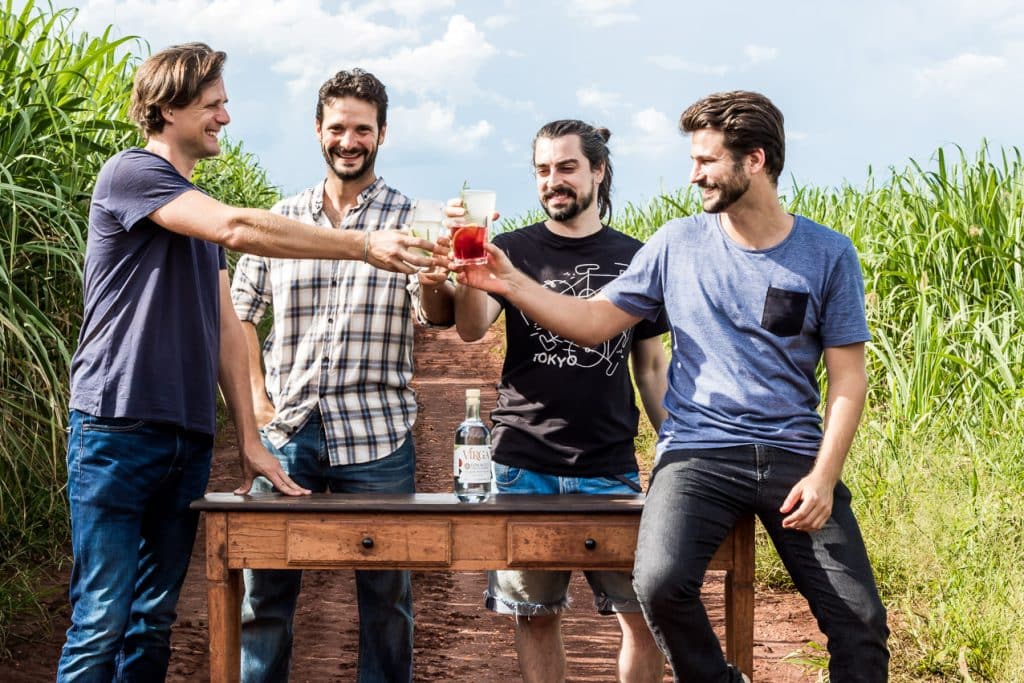
So this story actually, like many of my projects, came about in the bar. I was in a bar here in São Paulo and there I met a Dutch guy called Joscha. And gin is a Dutch drink and I lived in the Netherlands for a year too, so I knew gin and already knew a little about its history.
As I told you before, the Dutch have a tradition in producing distillates, they created gin, they helped create cachaça and I met this Dutchman and he proposed: we combine my story with cachaça and his story with gin. Joscha is from a city in the Netherlands called Schiedamn, one of the birthplaces of gin in Europe.
After a year of research, we launched the first artisanal Gin in Brazil called Virga. It is produced in Pirassununga at Fazenda Guadalupe, where Gabriel Foltran is one of the partners. And he uses a Brazilian plant called pacová, from the ginger and cardamom family. Pacová is a plant from the Atlantic Forest with a very tasty seed that resembles black pepper, mint and cardamom.
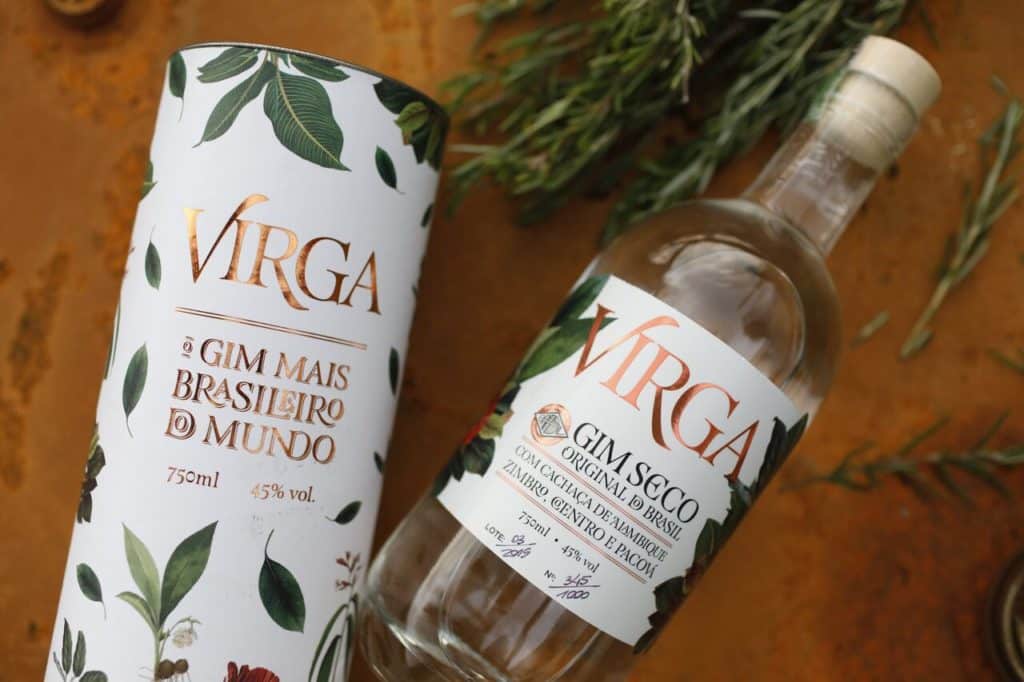
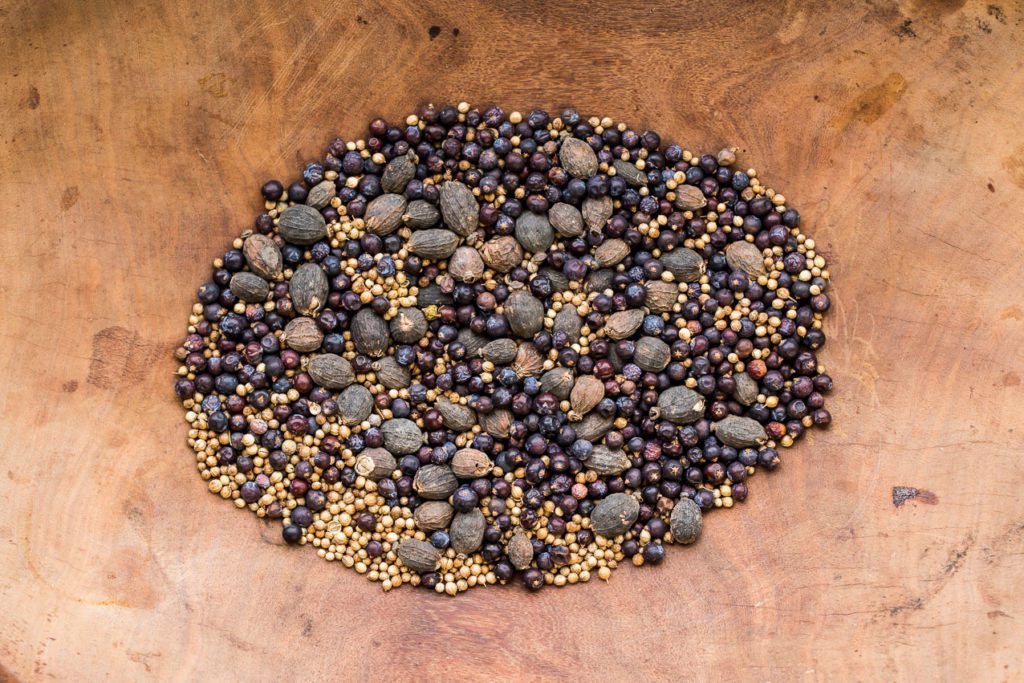
In the first batch of Virga, we found pacová in the cereals area of São Paulo, but when it was time to make the second batch there was no more and no one knew where it was. I remember that I then visited all the municipal markets here in São Paulo. Nobody knew what pacová was until I said: you know what, I'm going to go into the woods and look for it. And I ended up at Prumirim, a beach between Ubatuba and Paraty, a humid and shady region, which is typical of Pacová. And there, after I showed the photo of the pacová and people showed me there, you know, I couldn't believe it I saw my first fresh pacová tree.
We were very happy to have this pacová, to tell this story of it being a native plant from Prumirim in the Atlantic Forest and we also created a movement because people started talking about our Gin but also talking about pacová. So here in São Paulo today you go to some places or even in Paraty and people have used pacová to season cocktails, to season meat, to season salads, to season even pastry fillings.
And you can multiply this by 1000 by 2000 3000 because we have wonderful potential in our flora and biodiversity. Not only for gastronomy, but also for medicine. And I even joke that after we launched Virga I had two daughters… and one of the properties of pacová is a natural stimulant, so to speak…
Here in São Paulo we supply bars and restaurants and I'll tell you that the most enjoyable part of this whole process is the production. Produce the drink, you have a cachaça, you know. You think about the name, think about the label, do the alchemy of production, it's very enjoyable.
Nowadays, a lot of things are done online. For a long time also because of the Mapa da Cachaça I lived on the road, it ended up that life brought me to stay here in São Paulo largely because of my family and also because of a new project that we started two years ago, which was a distribution of these Brazilian products here in São Paulo, which is a company call BR-ME.
BR-ME aims to bring these Brazilian products, not only cachaça, but also wine, olive oil, chocolate, coffee to the public here in São Paulo. We have a distribution focused on São Paulo. So today we serve bars, restaurants and some emporiums here in São Paulo and we have an e-commerce that we can offer to the whole of Brazil.
And so because of this project I ended up settling here two years ago.
Tiquira, which is a cassava spirit, is made with cassava, which is a Brazilian plant. We brought the sugarcane from Asia, but the cassava is Brazilian. And today we even offer here in São Paulo the tiquira called Guaajá.
Even last month, the tiquira won the Geographical Indication of Maranhão. So today it's a heritage of Maranhão, tiquira is traditional there in Maranhão, but Brazilians still don't know it but when they drink it everyone is surprised because it's not cachaça, it's not whiskey, it's not vodka, it's something unique.
And you even feel it when you taste a flavor that reminds me of tapioca pudding, you know, it's a vegetable sweet, a sweet treat that reminds me of that pudding, it's very cool and is now part of our portfolio.
Those who produce wine or produce beer when in fact those who exaggerate regardless of drinking alcohol are alcohol. So, what is important for those who work on this topic is to always value moderate consumption, value conscious consumption, if you drink, don't drive, but in moderate doses it is an excellent social lubricant, we know that a meeting between friends with a good glass of wine or a good glass of cachaça it is special.
We are talking about a drink made with great care, with production using techniques today that use the best cachaça spirits in the world, so there are only reasons for us to celebrate this drink and without a doubt the more Brazilians recognize cachaça and speak well of cachaça the easier it will achieve global status.
The world wants what Brazil has to offer, not only in cachaça but also in other categories, which is diversity, which is complexity, which is innovation, the world is tired of just whiskey, the world is tired of just wine, and look for other things and Brazil has a lot to offer the whole world.
A selection of the best articles from Mapa da Cachaça on different topics
There are no results matching your search.
scratchesThe best of cachaça in your email